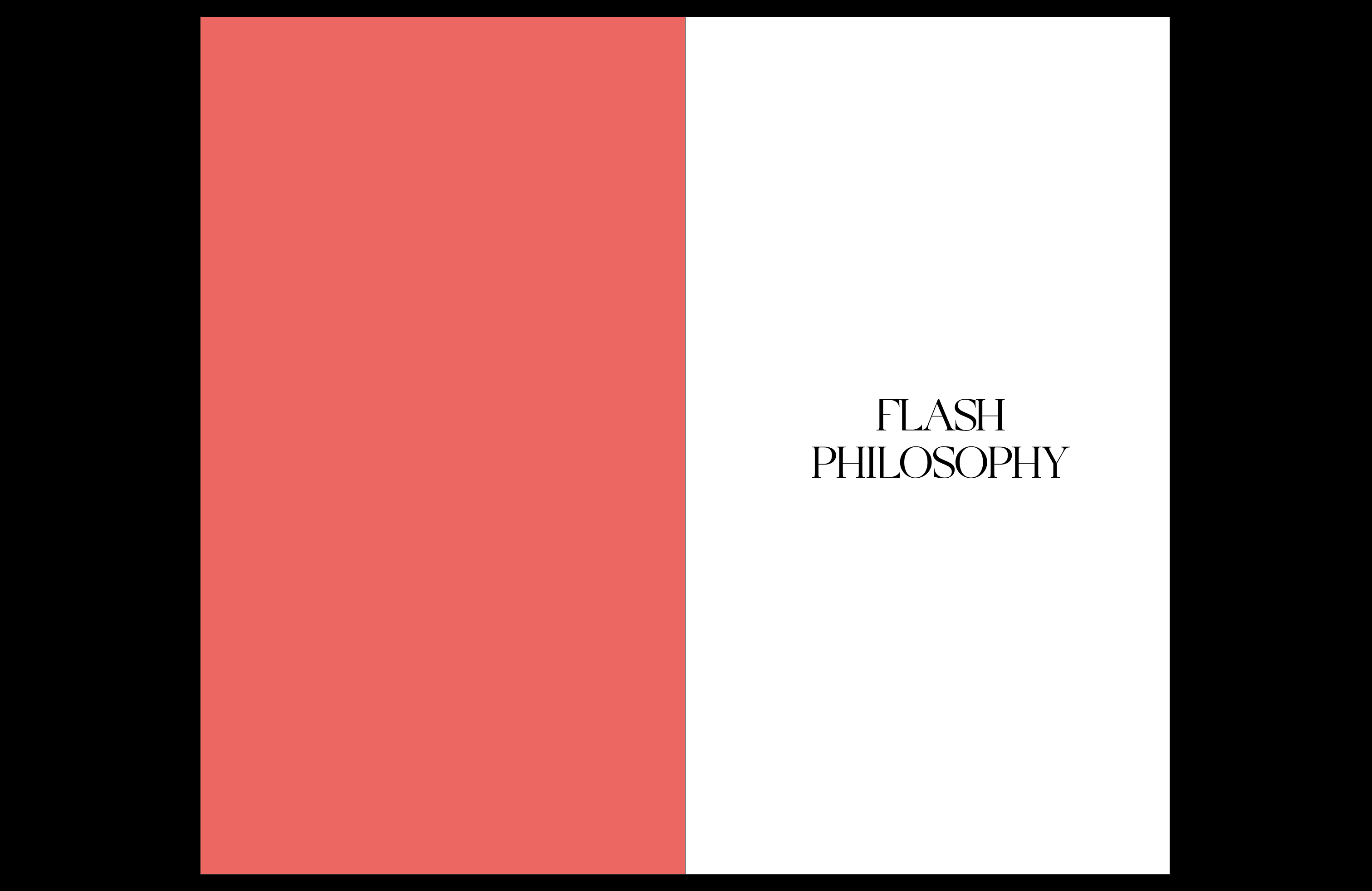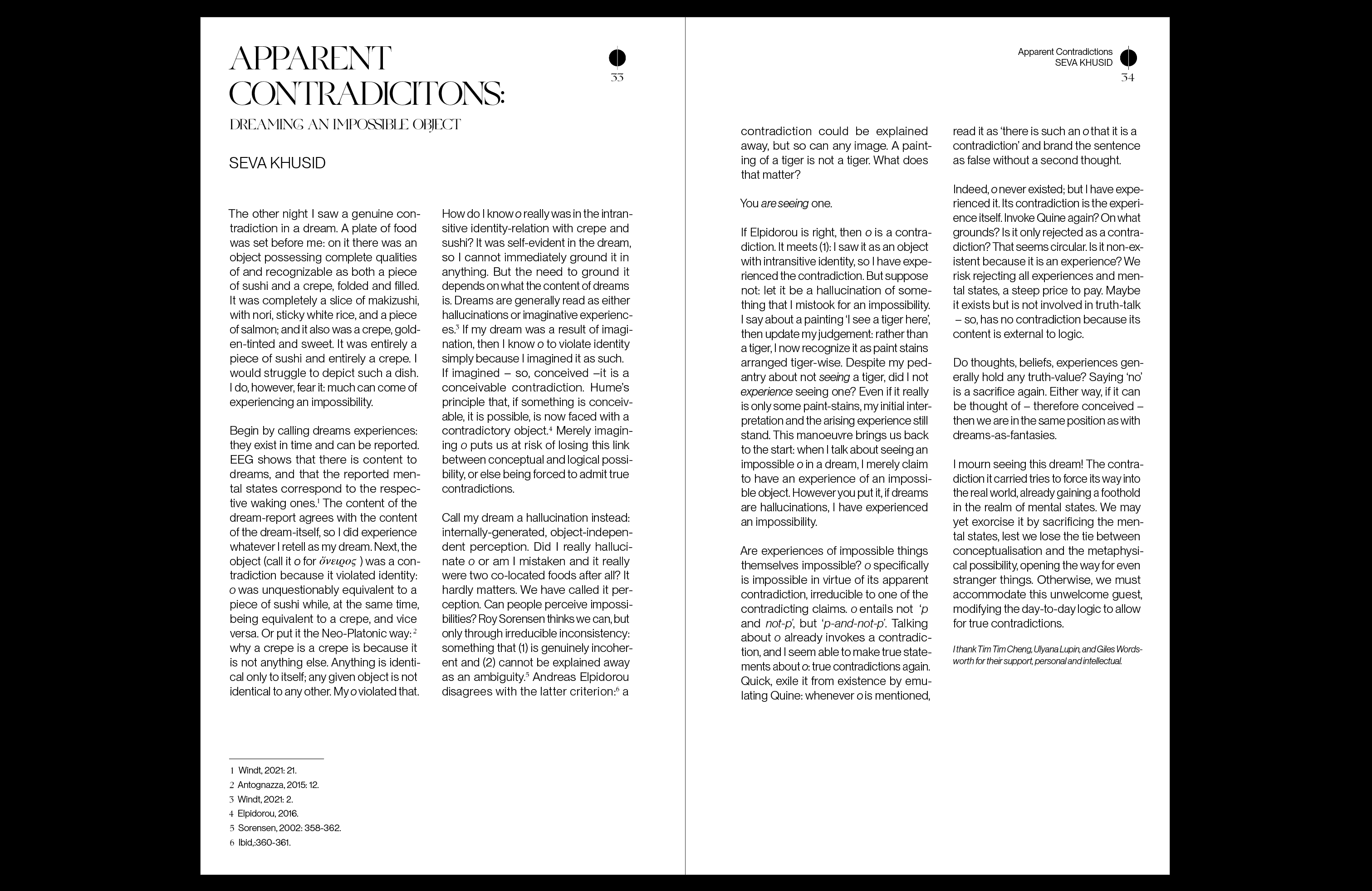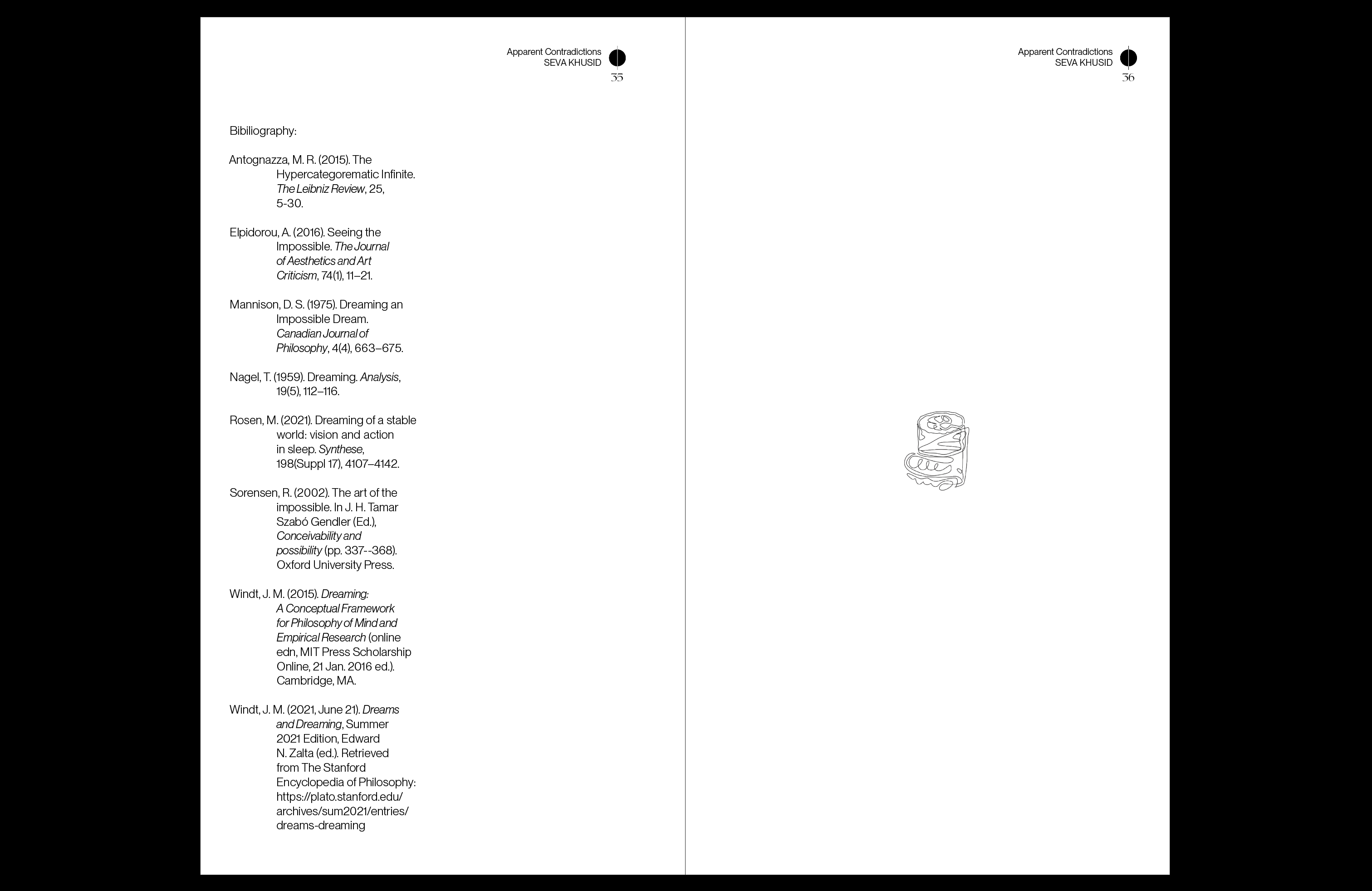


We believe that philosophy is not the only discipline equipped to interface with philosophical ideas. That is why our Interdisciplinary Philosophy Journal brings together aspiring and established professionals, from a range of mediums, methodologies and perspectives, to celebrate the collaborative insights of visual art, poetry, short-form fl ash essays, and long-form interviews.
Through this interdisicplinary format, we intend to promote and preserve what philosophy has to offer to those who are both familiar and less familiar with the field, in an accessible and engaging manner. Internationally distributed in book/zine stores by Public Knowledge Books, our journal aims to form something of a public engagement project to bring together and celebrate the scope of philosophical thinking.
Each issue of our Journal therefore comprises a ‘total work of art’: a carefully curated, interdisciplinary investigation of one theme within one design schema, in order to help generate novel insights and achieve a more unified vantage-point.
Issues No.1 and No.2 were funded by the June Cockburn Prize in affiliation with the University of Glasgow. Issue No.3 was in part funded by the University of Glasgow's Student Enterprise.
Issue No.4, exploring the theme of the 'interface' is forthcoming for 2025.
Past issues have involved the following philosophers: logician Graham Priest, metaphysicians Roy Sorenson and Ricki Bliss, philosopher/theologist John D. Caputo, as well as philosophy of language and aesthetics Gary Kemp, to name a few.
Our latest issue, on the theme of 'discourse' involves the recent authors of the book Metaphysical Animals, Racheal Wisemen and Clare Mac Cumhaill on the history of women in analytic philosophy and the Wartime Quartet, as well as M.G. Piety & Dan Wiedinmyer on revitalising the professionalis-ation of academic philosophy by reintroducing the old and forgotten essay form of 'flash philosophy' to its practitioners.


Contradictions hold a special place in the sport of philosophical discourse. They are typically regarded as something to avoid or resolve in the defence of an idea; otherwise, they are pursued and revealed in the offense of an idea.
The contradiction antagonises our affinity for consistency, rationality, and linearity. That some thing is and is-not, that some thing and its very negation should co- exist simultaneously and oppose one another is an ungraspable (im)possibility.
To contemplate contradiction requires a tolerance that philosophical discourse does not praise, nor incentivise. That they provoke nausea when expressed through paradox, evoke estrangement under the guise of cognitive dissonance, arouse the poet, rouse the philosopher, and amuse the artist is something to behold.
Such a task of investigation requires an attitude of tolerance for the ambiguity of conflict without resolve. What to do with these strange yet supposedly impossible possibilities is precisely what this issue hopes to achieve. In this first issue of Contralytic, our contributors investigate contradiction – some with ease, others not so much.
Flora Leask Arizpe
Alexander A. Cameron
Tim Tim Cheng
Serafina Cusack
Simon Kerola
Seva Khusid
Lucy Lauder
Lucille Mona Ling
Mahee Mustafa
Marily Papanastasatou
Graham Priest
Anniina Ruonala
Maria Sledmere
Roy Sorensen
Andrew Tamlyn
June 2023
ISSN: 2976-7385
13 x 23 cm
72pp
£9 / 10.50€




Circularity is a recurring theme in philosophical discourse. In addition to connoting a geometric property, circularity is present whether one is falling prey to fallacious circular reasoning (or being accused of as much), or setting off into the infinite epistemological and metaphysical quagmire of a regress, or perhaps even in the process of grasping a texts’ meaning, the philosophical contemplation of circularity is inevitable.
In a less technical sense, circularity is also manifest across cultural iconographies, signifying unity, renewal, and recurrence. This expresses a deep and intuitive grasp of the underlying self-regulating dynamics of nature, society, and the strange loops that we ourselves are.
From here we leave it to our readers to decide which aspects of circularity should be built, broken, and embraced, and what forms should be altered, maintained, and challenged.
INTERVIEWS
Professor John D. Caputo on history of philosophy and the hermeneutic circle, as well as the continental-analytic divide.
Professor Ricki Bliss from Lehigh University on the puzzles of circularity in metaphysics – from problems of self-reference, ontological grounding and infinite regresses.
ESSAYS
Konrad Paszek on the insights of hermeneutics to help us embracing the openness of understanding
Professor Gary Kemp on the historical contributions of the Vienna Circle’s core member, Carnap
Maté Tenke & Nic Sharp on the practical ethics of doughnut economics
VISUAL ARTISTS
Alessandro Keegan’s surrealist oil paintings of alien ecologies
Olafur Eliasson’s conceptual art, inviting observed to consider the divided self and one’s agency in a casually inter-connected world
Grit Richter’s exploration of the cyclical, almost infinite nature of life and it’s inter-generational relations
Katie Paterson’s capturing of deep-time in the form of a spherical fossils necklace and circular spectrum of cosmic light
Axl Kasper’s photography, exploring the reflexivity of mirror objects, paradoxes of self-reference and time
POETS
Kathrine Sowerby
Daisy Lafarge
K. Angel
Peter Thicket
Sun Yung Shin
December 2023
ISSN: 2976-7385
13 x 23 cm
76pp
£11 / 12.50€
Contradictions hold a special place in the sport of philosophical discourse. They are typically regarded as something to avoid or resolve in the defence of an idea; otherwise, they are pursued and revealed in the offense of an idea.
The contradiction antagonises our affinity for consistency, rationality, and linearity. That some thing is and is-not, that some thing and its very negation should co- exist simultaneously and oppose one another is an ungraspable (im)possibility.
To contemplate contradiction requires a tolerance that philosophical discourse does not praise, nor incentivise. That they provoke nausea when expressed through paradox, evoke estrangement under the guise of cognitive dissonance, arouse the poet, rouse the philosopher, and amuse the artist is something to behold.
Such a task of investigation requires an attitude of tolerance for the ambiguity of conflict without resolve. What to do with these strange yet supposedly impossible possibilities is precisely what this issue hopes to achieve. In this first issue of Contralytic, our contributors investigate contradiction – some with ease, others not so much.
Flora Leask Arizpe
Alexander A. Cameron
Tim Tim Cheng
Serafina Cusack
Simon Kerola
Seva Khusid
Lucy Lauder
Lucille Mona Ling
Mahee Mustafa
Marily Papanastasatou
Graham Priest
Anniina Ruonala
Maria Sledmere
Roy Sorensen
Andrew Tamlyn
June 2023
ISSN: 2976-7385
13 x 23 cm
72pp
£9 / 10.50€








Contradictions hold a special place in the sport of philosophical discourse. They are typically regarded as something to avoid or resolve in the defence of an idea; otherwise, they are pursued and revealed in the offence of an idea.
The contradiction antagonises our affinity for consistency, rationality, and linearity. That some thing is and is-not, that some thing and its very negation could co-exist simultaneously and oppose one another is an ungraspable (im)possibility. To contemplate contradiction requires a tolerance that philosophical discourse does not often praise, nor incentivise. That they provoke nausea when expressed through paradox, evoke estrangement under the guise of cognitive dissonance, arouse the poet, rouse the philosopher, and amuse the artist is something to behold.
Such a task of investigation requires an attitude of tolerance for the ambiguity of conflict without resolve. Exploring what to do with these strange, yet supposedly impossible possibilities, is precisely what this issue hopes to achieve.
In this first issue of Contralytic, our contributors investigate contradiction – some with ease, others not so much. Our poets address the cognitive dissonance ofbeing both enticed and repelled by patriarchal gestures; the perceptual contradiction between the fl ow and experience of time; the contradiction in expressing what is meant and what is said; the self-contradiction of never having asked for nothing, whilst wishing to have asked for something; and the contradiction of the lover’s pursuit of true selflessness and unity with the other, only to find reflections of themselves.
Our visual-artists depict the narrative of the contemplator of contradictions; represent how the body harbours contradictions; portray the predicament of interior and exterior space in modern social narratives and perceptions; and reveal the simultaneity of chaos followed by order.
Our flash philosophers revivify the cross-disciplinary predicament in confronting the contradiction; revealing the contradictory pursuit of seeking to clarify the notion of nothingness; exploring the pull towards what is both an initially liberating and purifying cultural movement, and its totalitarian and morally dubious outcomes; demonstrating arts ability to reconcile contradictory aesthetic experiences; and convincingly presenting an argument for the ungraspable, yet phenomenally legitimate, status of experiencing contradictions in dreams. Finally, our interviewees find themselves in contradiction: according to the former, contradictions are true; according to the latter, contradictions are false. Can they both be right? We leave that up to the reader.
INTERVIEWS
Professor Graham Priest, discussing the possibility that some contradictions are true according the position of ‘dialetheism’, as well as its historical development from both Western and Eastern philosophical traditions, its reception in recent times, and the global future of philosophy.
Professor Roy Sorensen discussing the essentiality of the principle of non-contradiction in opposition to dialetheism, the subtle art of ‘stealth’ philosophy, the perennial nature of the paradox, and the dividing lines of style, method and language between Analytic, Continental and Eastern philosophy.
ESSAYS
Flora Leask Arizpe offers a short, contradictory meditation on the concept of nothingness
Mahee Mustafa explores the seemingly opposing forces of Romanticism and Fascism
Alexander A. Cameron reconciles the contradictory aesthetic experiences assumed by notions of the sublime and the beautiful
Seva Khusidc convincingly argues that dreaming contradictions forces us to confront what kind of epistemic status we must grant our experience – wakeful or not
VISUAL ARTISTS
Andrew Tamlyn illustrates a being capable of contemplating contradiction
Anniina Ruonala represent how the body harbours contradictions among others’ and within itself
Simon Kerola playfully captures the opposing tension of interior and exterior, negative and positive space, foreground and background
Marily Papanastasatou reveals the harmonious co-existence of chaos and order
POETS
Maria Sledmere
Lucy Lauder
Tim Tim Cheng
Serafina Cusack
Lucille Mona Ling
December 2023
ISSN: 2976-7385
13 x 23 cm
76pp
£11 / 12.50€
Contradictions hold a special place in the sport of philosophical discourse. They are typically regarded as something to avoid or resolve in the defence of an idea; otherwise, they are pursued and revealed in the offense of an idea.
The contradiction antagonises our affinity for consistency, rationality, and linearity. That some thing is and is-not, that some thing and its very negation should co- exist simultaneously and oppose one another is an ungraspable (im)possibility.
To contemplate contradiction requires a tolerance that philosophical discourse does not praise, nor incentivise. That they provoke nausea when expressed through paradox, evoke estrangement under the guise of cognitive dissonance, arouse the poet, rouse the philosopher, and amuse the artist is something to behold.
Such a task of investigation requires an attitude of tolerance for the ambiguity of conflict without resolve. What to do with these strange yet supposedly impossible possibilities is precisely what this issue hopes to achieve. In this first issue of Contralytic, our contributors investigate contradiction – some with ease, others not so much.
Flora Leask Arizpe
Alexander A. Cameron
Tim Tim Cheng
Serafina Cusack
Simon Kerola
Seva Khusid
Lucy Lauder
Lucille Mona Ling
Mahee Mustafa
Marily Papanastasatou
Graham Priest
Anniina Ruonala
Maria Sledmere
Roy Sorensen
Andrew Tamlyn
June 2023
ISSN: 2976-7385
13 x 23 cm
72pp
£9 / 10.50€

